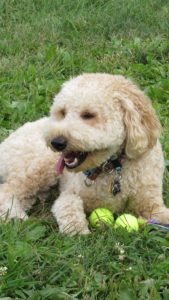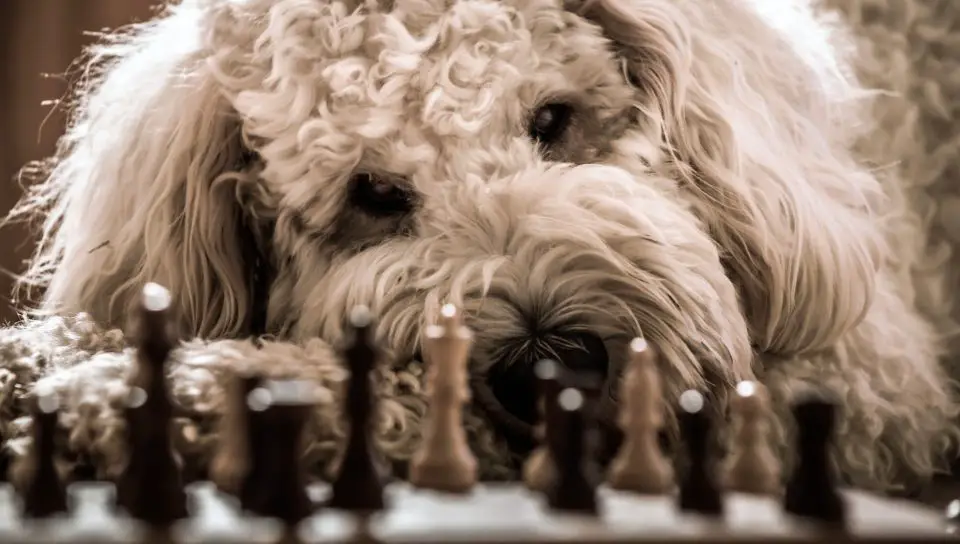Hi I’m Tiara Nixon and I’m going to share my top tips for training this breed, whether you are starting with a young puppy or have adopted an older Doodle.
The Goldendoodle is a wonderful family dog.
With an easygoing, friendly personality and high intelligence, this breed is generally easy to train and gets along with everyone.
Goldendoodles: A Golden What?
The Goldendoodle was first bred in the late 1960’s, though the breed did not become popular until the 1990’s.
This cross between a Golden Retriever and Standard Poodle was an attempt to create a service dog that would be suitable for people with allergies.
The amazing combination created a curly or wavy coated, long legged golden colored dog with a good temperament, and, generally speaking, doesn’t shed or give off dander- which is the biggest cause of allergies to dogs.
The Golden Retriever isn’t the only breed to be crossed with the Poodle, the Labrador also has this distinction, creating the Labradoodle.
The Challenges of Training a Goldendoodle
I started seeing Goldendoodles appear in my group training classes in the late 90’s and always found them to be fun dogs to work with.
But not all is rosy with this breed, so let’s get the challenges of training them out of the way early.
Goldendoodles are typically very friendly. They tend to love everyone they meet and want to greet or play with everyone they encounter.
This exuberance can sometimes lead to a dog that is difficult to focus. Therefore, I suggest you use high value rewards-more on this later- when working with your Doodle.
Goldendoodles tend to be higher on the energy spectrum. Training a dog with pent up energy is basically not going to happen. If it does, it’s likely you’ll end up frustrated and worn out!
One smart solution to an energizer dog is to train them to use a treadmill.

The internet is chock full of videos and ideas on how to train this activity and online classifieds provide a large selection of affordable used treadmills.
Here’s a cool looking treadmill I found online, that’s specifically for dogs!
Let’s Talk About Treats Baby
The magic key to unlocking your dogs training potential is knowing when to up your game.
Sometimes a basic treat or piece of kibble is enough to motivate a dog, and other times they might ignore it as there is something more interesting to them.
Sometimes it’s as simple as the dog having too much energy and playing is of higher value to the dog than the reward you are offering.
Think of training rewards as a paycheck for your dog. When you are working, are you going to work hard for minimum wage if you can get away with working the bare minimum?
Not likely. But, if offered great deal of money for the same task, chances are you’ll do the work- and do it with enthusiasm!
Knowing when to offer high value rewards to your dog will take you far in training. You will not always need to resort to the “good stuff” but if your dog seems uninterested in training, try offering some high value rewards before giving up in frustration.
Remember that dogs have an incredible sense of smell. It’s so strong that we pitiful humans can not even fathom it. My point here is that you do not need to offer giant pieces of reward in order for your dog to be happy about it.
If the value is high enough, a tiny taste (over and over) is often enough. I suggest cheese or hot dog- cut up into small pieces- as high value rewards, though your dog may be satisfied with a soft food or soft training treat.
As always, use care when selecting rewards for your dog. Be sure not to offer anything that may upset their stomach or that is toxic for dogs.
Starting Training Goldendoodles Young
 Goldendoodles are comprised of two working dogs so chances are your Doodle will have a fair amount of energy.
Goldendoodles are comprised of two working dogs so chances are your Doodle will have a fair amount of energy.
None the less, Doodles of all kinds tend to do really well with crate training and potty train fast- as long as you are consistent.
Even the smartest breedsindividuals need consistency to know what to do, so be sure you are training on a schedule, the same way each time.
This bright breed makes puppy training a breeze, provided you meet your baby’s energy needs. Don’t be surprised if your youngster learns the basics early- sit, down, and stay.
Online dog trainer Adrienne Farricelli has a wonderful program called Brain Training 4 Dogs which is a great resource for starting your puppy the right way.
This affordable program will set you up for total success and teach you stress-free ways to work with your puppy.
The game training is also good for adult dogs- it’s fun and engaging and doesn’t seem like “training” which is one reason I love it.
You can view my full Brain Training for Dogs review here!
Use a Clicker: Click It
There are many ways to train a dog. In general, and especially with higher energy breeds, I tend to prefer clicker training. It’s fast and easy for both the dog and human to master.
The reward (the click) comes quickly after the action so the dog is able to make the bridge between the desired behavior and the sound that equals FOOD.
If your food reward is of the correct value for your dog, you should see quite a bit of motivation from your dog to get the click.
Golden Doodle Training Tips
Tip #1- Be Consistent
This is the most important tip to training, whether you are working with a puppy or adult dog. Consistency is key.
This can mean a lot of things, but the context I’m referring to is be consistent with your training, i.e. every day, and be consistent with the way you train.
If you ask your dog to sit 5 different ways before he has had a chance to master it, what do you think will happen?
First of all, it will slow down training, secondly it will confuse your poor pooch.
Tip #2- Practice Makes Perfect
 This seems like a given, but what most people do is learn a teaching method with their dog.
This seems like a given, but what most people do is learn a teaching method with their dog.
I highly suggest you practice the technique without your Doodle so that it is easier for you when you’re working together.
It’s easy to practice on your own when working with videos like the ones presented in Brain Training 4 Dogs, you have the opportunity to watch, and watch again, to refine your movements before using them on your dog.
What I love about training from videos is that you can have it going while you are training for a quick, visual reference.
This is almost as good as being in a class, in some cases better because there are no distractions.
The downside is being unable to get instant feedback when you stumble, but if time or financial constrains make joining a class tricky, videos are the second-best way.
Of course, practice is needed for you dog too, and this goes back to tip 1. Be consistent in training your dog every day, even if for only a few minutes.
We all know life gets in the way and there will be days you don’t feel like it but do it anyway. Even if it’s just 5 minutes. Your future self with thank you!
Just be sure to pick a task that will not frustrate you or your dog. These kinds of days are good ones to reinforce something your Doodle already knows rather than try something new.
Tip #3- Don’t Train When Hyper
It’s okay if your dog is a little hungry when training, but you don’t want to work with a Goldendoodle who is energy bound.
Make sure you have provided your dog with exercise before you attempt to train.
This can be a vigorous walk, playing, a trip to the dog park- no matter what you choose, set you and your dog up for success instead of frustration.
Yes, it’s possible a dog with energy can learn something new and do it with enthusiasm, but the mind won’t be as engaged as we prefer because the energetic body has more dominance at that moment.
Tip #4- Learn What You Want
 All dog training programs have a pattern of activities they think you need to learn.
All dog training programs have a pattern of activities they think you need to learn.
Some are necessary as they are potentially life saving (I always stress the importance of taking the time train a reliable recall) but you do not have to train in the sequence that is provided to you.
For example, stay might be more important to you than down. This is especially true for dogs who like to bolt out the door!
A lot of training programs are set up in a progression where the activities build on to each other. This makes it wise to start at the beginning and follow the steps, but just know that you don’t have to.
If your dog is jumping on you at feeding time, you might want to work on training that will help with that real-world situation before other things.
Tip #5- Speaking of Frustration
Anger does not belong in dog training. Unintentional training is real and can be a big problem when we let any negative emotions into training.
Dogs are such agreeable creatures that it’s easy to forget that they are much more in tune with nonverbal cues than we are. In fact, they are masters in nonverbal communication!
Not only that, they can smell changes in our body chemistry. What I’m getting at is your Doodle knows if you’re unhappy. Even if she doesn’t show it or change her behavior to reflect yours.
Some people think dogs “know” when they’ve been “bad” because they get a sad look on their face, cower, lick, and tuck their tails. Truth is, your dog is reacting to YOU, not the knowledge they have done something.
When we come home and find a couch cushion chewed up, we immediately start giving off signals that we are unhappy. Typically, our tone of voice changes, our expression, and even posture change.
We call the dog over and direct this communication at her. These cues are what the dog is responding to, not a knowing that they have done something “wrong”.
In reality, your dog only knows when it has done an unwanted behavior when you correct it in the moment.
Meaning, in order to connect your dog with the “bad” or unwanted behavior, you need to provide correction or redirection while it is happening. The same goes for reinforcing a “good” or wanted behavior.
Less sensitive dogs may not react to your cues with the face, cowering, and tail tucking, but that doesn’t mean they aren’t studying your cues.
You may have a very confident dog who doesn’t get afraid when you’re reactive, but you should always keep in mind you can unintentionally train the confident dog as much as the sensitive one.
When we get frustrated during training, there is always a reason. The reason may be ours or the dogs, but before getting reactive (frustrated) you should pause and try and determine the reason.
If your dog does not seem to be trying, it could be your reward is not of enough value, or perhaps it is your dog’s naptime. If your dog doesn’t seem to be “getting it” take a look at how you’re presenting the information.
A small tweak to technique can sometimes make a huge difference. Or maybe you’ve had a long, stressful day and you are trying to teach your dog something new.
There are a lot of things that can go wrong in this scenario, which is why I suggest reinforcing training rather than starting something new.
If you find you can’t keep negative emotions in check, stop training. It’s ok. I give you permission.
Final Thoughts
Being a cross between two highly intelligent breeds, the Goldendoodle is fairly easy to train.
Whether you are starting from a puppy or adopting an adult, the Goldendoodle’s willing personality, and it’s love of people make for a quick student.
Remember to provide an energetic Doodle with plenty of exercise to get the mind right for training.
Keep in mind this breed was developed for service work which means the fun you can have training is limitless.
If you’re looking for an affordable training program to help you out, I suggest checking out my article on Brain Training for Dogs here.
If you have any comments or questions, please feel free to leave them below!

